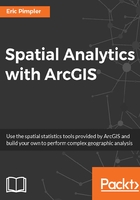
上QQ阅读APP看书,第一时间看更新
Running the Central Feature tool
The Central Feature tool identifies the most centrally located feature from a point, line, or polygon feature class. It sums the distances from each feature to every other feature. The one with the shortest distance is the central feature.
This tool creates an output feature class containing a single feature that represents the most centrally located feature. For example, if you have a feature class of burglaries, the Central Feature tool will identify the crime location that is the central most location from the group and it will create a new feature class with a single point feature that represents this location.
Let's take a look at the following steps to learn to run the Central Feature tool:
- If necessary, open ArcToolbox and find the Spatial Statistics Tools toolbox. Open the toolbox and expand the Measuring Geographic Distributions toolset. Double-click on Central Feature to display the tool, as shown in the following screenshot:

- Select Denver Burglary as the Input Feature Class, C:\GeospatialTraining\SpatialStats\Data\crime.gdb\Burglary_CentralFeature as the Output Feature Class, and EUCLIDEAN_DISTANCE as the Distance Method. Euclidean distance is a straight-line distance between two points. The other distance method is Manhattan distance, which is the distance between two points, measured along axes at right angles and it is calculated by summing the difference between the x and y coordinates.
- There are three optional parameters for the Central Feature tool, which are Weight Field (optional), Self Potential Weight Field (optional), and Case Field (optional). We won't use any of these optional parameters for this analysis, but they do warrant an explanation:
- Weight Field (optional): This parameter is a numeric field used to weight distances in the origin-destination matrix. For example, if you had a dataset containing real estate sales information, each point might contain a sales price. The sales price could be used to weight the output of the Central Feature tool.
- Self Potential Weight Field (optional): This is a field representing self-potential or the distance or weight between a feature and itself.
- Case Field (optional): This parameter is a field used to group features for separate central feature computations. This field can be an integer, data, or string.
- Click on the OK button.
- The most centrally located burglary will be displayed as shown in the following screenshot. The output is a single point feature:

Most centrally located burglary